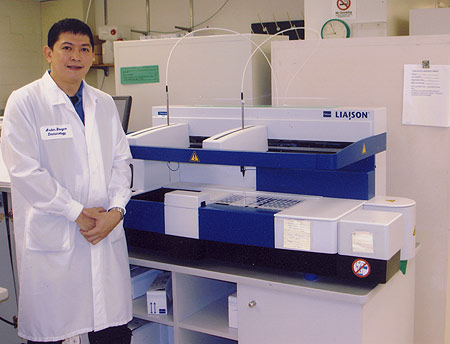 It seems that no matter where I turn, I hear or read reports about vitamin D. It is on the nightly news, in magazines and all over the Internet. It seems that almost every disease state known to man has some connection to vitamin D. At the moment, it is one of the most talked about laboratory tests. Pathology receives more than 20,000 send-out requests per year for vitamin D levels. Beginning June 1, 2009, the Immunology Laboratory will be offering this testing in-house. The Immunology Laboratory has validated the vitamin D chemilumenescence immunoassay on the automated Liaison instrument. This method accurately measures both vitamins D2 and D3 together and is reported as a total 25 (OH) vitamin D. The turnaround time for results is expected to decrease by 3 days as the Lab will be running the test Monday through Friday. The majority of the time, we will provide same-day results. We have on-site consultation for questions or concerns.
It seems that no matter where I turn, I hear or read reports about vitamin D. It is on the nightly news, in magazines and all over the Internet. It seems that almost every disease state known to man has some connection to vitamin D. At the moment, it is one of the most talked about laboratory tests. Pathology receives more than 20,000 send-out requests per year for vitamin D levels. Beginning June 1, 2009, the Immunology Laboratory will be offering this testing in-house. The Immunology Laboratory has validated the vitamin D chemilumenescence immunoassay on the automated Liaison instrument. This method accurately measures both vitamins D2 and D3 together and is reported as a total 25 (OH) vitamin D. The turnaround time for results is expected to decrease by 3 days as the Lab will be running the test Monday through Friday. The majority of the time, we will provide same-day results. We have on-site consultation for questions or concerns.
So what is all the fuss about vitamin D?
I grew up thinking of it as the “sunshine” vitamin. I remember my mom saying, “Go out in the sun. You need to make your bones strong!” Now growing up with freckles and red hair, the sun was not always my friend……BUT it beat the spoonfuls of cod liver oil that some of my friends received! Ughhh! I know there are a few of you out there that know exactly what I am talking about. The sun contributes significantly to the daily production of vitamin D. It is said that as little as 10 to 30 minutes of exposure each day is enough to prevent deficiency. Vitamin D is a fat-soluble vitamin naturally present in fish (salmon, tuna, and mackerel), eggs, and cod liver oil. It is added to other foods, such as fortified milk, orange juice, and cereals, and it is available as a dietary supplement. Vitamin D refers to several different forms of this vitamin. There are two forms that are important to humans: ergocalciferol (vitamin D2) and cholecalciferol (vitamin D3). Vitamin D2 is synthesized by plants. Vitamin D3 is synthesized by humans in the skin when exposed to ultraviolet-B rays from the sun. Foods may be fortified with either vitamin D2 or D3.
Vitamin D obtained from the sun, food or dietary supplements is biologically inert. It must undergo two hydroxylations in the body in order for it to be activated. The first hydroxylation occurs in the liver. It is here that vitamin D is converted to 25- hydroxyvitamin D [25(OH)D] also known as calcidiol. The second hydroxylation occurs in the kidney and forms the physiologically active 1.25-dihydroxyvitamin D [1,25(OH)2D] also known as calcitriol.
The major biologic function of vitamin D is to maintain normal blood levels of calcium and phosphorus. Vitamin D is needed for the absorption of calcium, which helps to form and maintain strong bones (Mom was right!). Research also suggests vitamin D may provide protection from osteoporosis (a disease of bone that leads to fractures), hypertension (high blood pressure), cancer, several autoimmune diseases, as well as a host of other maladies. Vitamin D has other roles in health, including modulation of immune function and the reduction of inflammation.
Classic vitamin D deficiency diseases include Rickets and osteomalacia. In children, vitamin D deficiency causes rickets, which is when the bones become thin, brittle or misshapen — potentially leading to fractures and skeletal deformities. In adults, vitamin D deficiency can lead to osteomalacia, a condition that results in muscular weakness in addition to soft, weak bones. Who may be at a high risk for vitamin D deficiencies? This group includes the elderly, infants who are fed a diet of strictly breast milk, obese individuals, and those who have limited sun exposure. Individuals who have fat malabsorption syndromes, such as cystic fibrosis or inflammatory bowel disease, such as Crohn’s disease, are also at risk for deficiencies in vitamin D. Despite the importance of the sun to vitamin D synthesis, it is prudent to limit exposure of the skin to sunlight. With the advent of sunscreen protection to quell an estimated 1.5 million skin cancers per year and prevention of age-associated dryness and cosmetic changes, sun exposure has dropped dramatically among the population. We are now seeing a rise in vitamin D deficiencies.
Serum concentrations of 25(OH)D are the best indicator of vitamin D status. It reflects vitamin D produced in the skin from the sun as well as that obtained from food and supplements. There has been considerable discussion about the serum concentrations of 25(OH)D associated with sufficient levels. Most authorities agree that a concentration of greater than or equal to 32 ng/mL is a sufficient level for bone and optimal overall health. Any level less than 32ng/mL is considered inadequate.
I leave you with this one question: What is your vitamin D status?
Ame’ Maters
Manager, Microbiology and Immunology Laboratories
